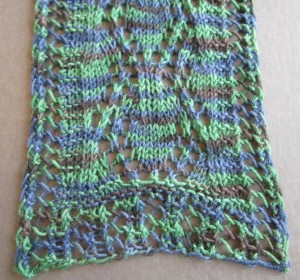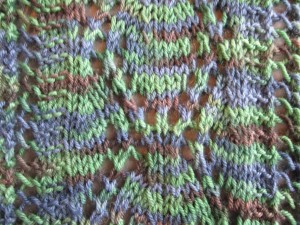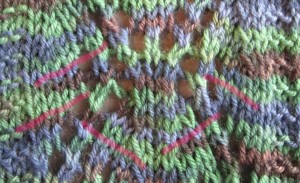simple dramatic effects in lace
Some of the most interesting and versatile lace stitch patterns are in fact the simplest to knit. I am particularly fond of the ones that undulate organically without any extra effort on my part. This is called a bias lace fabric. Many of the most beautiful lace patterns make extensive use of bias.
The Meaning of Bias in Lace
In lace, the term “bias” refers to knitted stitches that lie on an angle instead of vertically.
Tip: Although you might have grown accustomed to thinking of bias as a bad thing in knitting, in lace we are talking about a good thing!
Bias stitches add movement to knitted fabric, creating an organic feeling and visual excitement. The effects can be seen in both the interior of the pattern area as well as at the edges.
First, the stitches on an angle create a dimensional quality to the pattern design by creating shapes that seem to add depth to the fabric. Second, they affect the outline of the pattern’s edges, causing some or all sides to scallop and zigzag.
What Causes Bias in Lace
When yarn over increases are separated by one or more plain stitches from their compensating decreases, bias lace fabric will occur.
Let’s look at the Lace Leaf pattern stitch used in the Main Area of the Spring Lace Leaves Scarf as an example of a bias lace stitch pattern.
After you have worked several rows of the Main Area, do you see what is happening?
The lower edge of the Main Area has an upward scallop. This is caused by non-adjacent yarn over increases and their compensating decreases on rows 1, 3, 5.
Now look at the edges between the central Lace Leaf area and the Inner Border. They are wavy rather than straight.
The side edges have a zigzag shape. Also, the stitches within the main Lace Leaf area are at a tilt. The effects are especially noticeable in a variegated yarn where you can see the tilt of the rows of stitches. I have highlighted some areas in red below to demonstrate this.
For all these years I have knitted lace, I still find bias lace patterns extremely exciting to both knit and enjoy the result. I hope you do, too!





 HeartStrings FiberArts
HeartStrings FiberArts Knitting Bits of Lace on Facebook
Knitting Bits of Lace on Facebook Ravelry Store
Ravelry Store
Pingback: Edging Options for Tea-Time Serviette | Knit HeartStrings Learn-and-Knit-Alongs